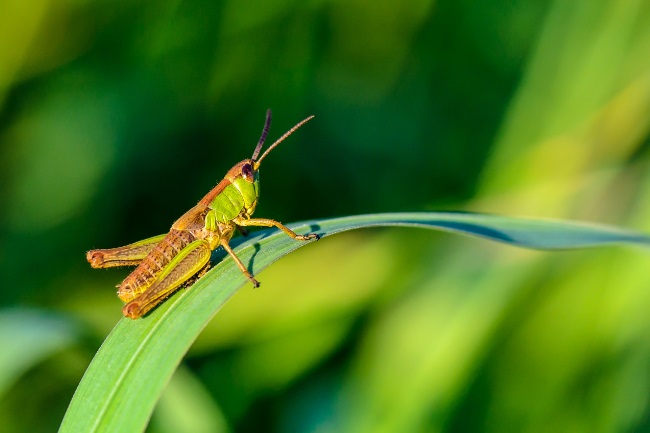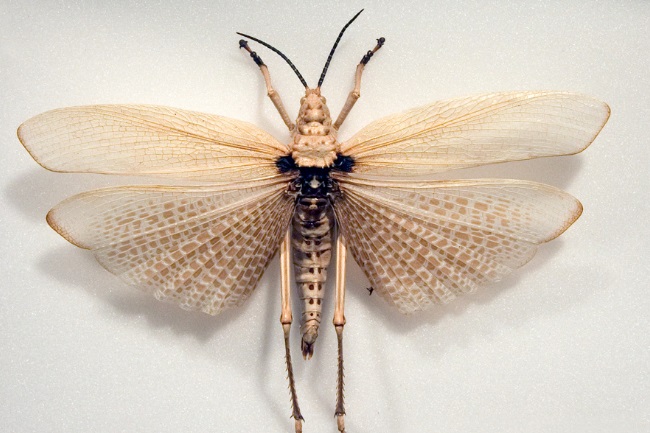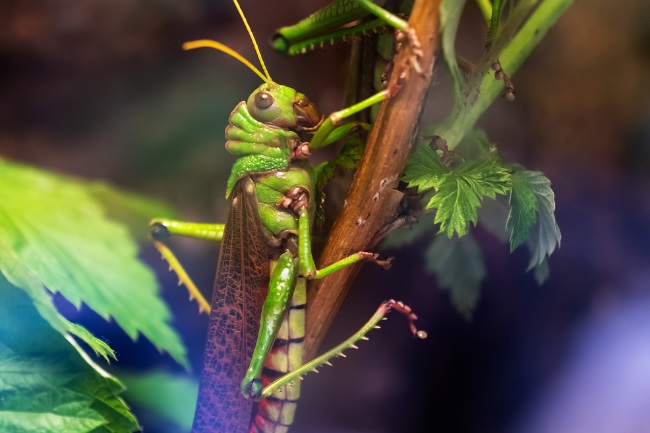Most grasshoppers have wings, though some have evolved to have very small wings. Many use their wings to fly, either to escape predators, migrate or as part of their mating ritual. Some do not fly, either because their wings are too small to carry them, or because they prefer to walk or hop instead.
Contents
Do grasshoppers have wings?

The majority of adult grasshoppers do have wings. Grasshoppers start life as an egg, hatching into an immature grasshopper, known as a nymph or hopper. The nymphs look like miniature versions of the adult grasshoppers, with the notable exception that they do not have wings. These wings develop throughout the five stages of moulting that the nymph goes through. The cycle from juvenile to adult takes about six weeks in most species, with the wings being fully developed by the time they reach adulthood.
| Wing Type | Description |
|---|---|
| Forewings | Thickened and protective wings located at the front of the grasshopper’s body. |
| Hindwings | Thin and membranous wings located at the back of the grasshopper’s body. |
| Tegmina | Modified forewings that provide protection and cover the hindwings at rest. |
| Flight Wings | Hindwings used for flight, typically larger and more efficient for generating lift and propulsion. |
As with all insects, the wings are located on the thorax. This is the midsection of the grasshopper, after the head. As a rule of thumb, the head holds the eyes, antennae and mouthparts, the thorax, the legs and wings, and the abdomen, the digestive system and genitalia.
How do grasshoppers fly?

Named after their ability to bound through the grasses, we tend to associate grasshoppers with their large, strong legs. Yet, depending on the species, flight can actually be a more important method of transport than walking or hopping.
Like other insects, such as beetles, grasshoppers have a hardened forewing known as an elytron. These protect the hindwing, which is much thinner and more delicate. The hindwing is what actually allows certain species to fly, while the forewing is what is used for stridulation, a type of sound production where the leg is rubbed against the wing casing. The hindwing is folded under the forewing to protect it.
Although most grasshopper species develop wings, in some, they are too stunted to be of any use. This is particularly common in those species that have evolved more to move by walking or hopping. The eastern lubber grasshopper, for example, has wings that are usually only half the size of its abdomen, meaning they are not big enough to carry its weight.
| Mechanism | Description |
|---|---|
| Wing Movement | Grasshoppers generate flight by rapidly moving their hindwings in a horizontal figure-eight pattern. |
| Lift Generation | The wings’ upward and downward strokes create lift, allowing grasshoppers to stay airborne and control altitude. |
| Propulsion | The wing movement also generates forward thrust, propelling the grasshopper through the air. |
| Wing Coordination | The coordination between forewings and hindwings ensures synchronized flight movements. |
| Wing Folding | Grasshoppers fold their wings parallel to their body when at rest, protecting them and conserving energy. |
Other grasshoppers may have larger wings but not be strong enough to keep themselves aloft for long periods of time. Instead they may launch into short flights or glides. These short bursts of flying can still be very useful for a rapid escape from hungry mouths or to impress the ladies.
Also read: How Far and High can Grasshoppers Jump? (Who Jumps Best?)
Why do they have to fly?
Grasshoppers have an astounding range of uses for their wings, some even using them for several different tasks across their lifcycle.
| Purpose | Description |
|---|---|
| Predator Avoidance | Flight allows grasshoppers to escape from predators by quickly moving to a safer location. |
| Food Search | Grasshoppers can fly to find new food sources, especially in cases of food scarcity or competition. |
| Mate Search | Flight enables male grasshoppers to search for female mates and establish territories. |
| Dispersal | Grasshoppers use flight to disperse and colonize new habitats, expanding their range. |
| Seasonal Migration | Some grasshopper species engage in seasonal long-distance migrations for better feeding and breeding conditions. |
For migration
We rarely think of grasshoppers as migrating, but a surprising number are strong enough fliers to travel long distances in search of more suitable climates or higher food availability. The migrating grasshopper of North America is so famous for being on the move they’ve even stuck it in the name. This grasshopper can travel 30 miles a day at 10- 12 miles per hour. It might not seem very fast for us but it’s a fair speed for a little insect.
Many migrating species take advantage of the wind, either at ground level or high up. Aerial surveys have found swarming grasshoppers as high as 13,000 feet. The jet stream can be an insect highway, these fast winds providing a boost for insects on the move. Warm weather also benefits migration, providing a thermal lift.
Avoid potential danger
Many grasshopper species use short flights to escape predators. This is a trick utilised both by those who can only jump and glide, and those that can fly great distances. Bird grasshoppers are a group of species well-known for their great flying ability, their bird-like movements having given them their name. Some of these species will fly up into a tree if disturbed.
Many species of grasshopper have brightly coloured hind wings, from red to blue to yellow. This shock of colour can confuse and scare predators, making them give up on their potential meal. The colours can also warn predators that these species might carry toxic poisons that would make them unpleasant to eat, accumulated from the plants they’ve been eating.
The aptly named red-winged grasshopper has beautiful scarlet hindwings. These wings can be both for protection and for romance as bright colours can indicate a younger, healthier male.
Mating

Most grasshoppers woo their ladies by playing a lovely piece of string music into the late evening air. They do this by rasping raised bumps on their legs across their hardened forewings. Some species however, practice crepitation. This is where they pull their wings taut during flight and make a cracking sound. The males spend their time in areal battle with other potential suitors, whizzing through the air snapping their wings.
The green striped grasshopper uses its noisy wings both during its mating display and to scare away predators. Its mating flight lasts only a few seconds, though it can fly much further to escape a hungry mouth.
For movement
As well as migration, many grasshoppers simply use flight as a means to get around. While walking and hopping are useful, flight can be a quicker and simpler way to get from plant to plant in a crowded landscape. Flying can be faster and take them further, but it can also make them more visible to predators, so there’s always a risk as well as a reward.
Do American grasshoppers fly?

Often known as short-horn grasshoppers in America, they are distinquished from long-horn grasshoppers, also known as katydids, by the length of their antennae. Most species of American grasshoppers can fly, or have wings but choose not to use them.
There are a number of wingless species, however one group known for their lack of interest in flight is the lubber grasshoppers. Lubber grasshoppers are some of the largest grasshoppers in America and include the buffalo grasshopper. Some species are wingless, but many are capable of flight but simply prefer to walk or hop. This is probably down to their large size, which means flight is highly inefficient.
Many American grasshoppers are excellent fliers, travelling great distances to find suitable grazing areas or somewhere to lay their eggs. The American bird grasshopper is known for its vast swarms, which can decimate croplands in poor years.
Do European grasshoppers fly?
Like American grasshoppers, the majority of European grasshoppers can fly. The mottled grasshopper uses its wings to take short flights, both for locomotion and to escape predators. It is found from the UK across into Russia and down to Morroco.
Grasshoppers with wings
Horse Lubber Grasshopper
The horse lubber grasshopper is a stunning looking insect with dark black colouration, and yellow and pink highlights. It’s found across the southern states, mainly living in fields and roadsides. Its pink wings act as a deterrent to potential predators, but like many species of lubber grasshopper, it’s not a keen flier. It also produces tobacco spit to put off would-be predators, which are deterred by the unpleasant taste.
Bird Grasshopper
The mischievous bird grasshopper might not be as exciting to look at as the horse lubber, but its name alone gives it tonnes of character. Its whole body is a rich caramel brown. Like other bird grasshoppers, it’s an excellent flier. However, this perhaps isn’t so great considering that it can become a serious crop pest.
Red-Legged Grasshoppers
Red-legged grasshoppers are excellent fliers and can fly up to 40 feet when trying to escape prey. They live on wet meadows and eat a variety of grasses. They are dark reddy green in colour, with striped legs. These grasshoppers eat a wide variety of food, including a number of vetches, dandelions and ragweeds.
Common Field Grasshopper
The common field grasshopper is, as the name suggests, a frequent species across Europe. It feeds mainly on grasses. Like most grasshoppers it stridulates, singing to its mates. Often green and grey in colouration, it can have colours of purple and orange too. It uses flighty largely to get away from predators.
Large Marsh Grasshopper
The large marsh grasshopper is an attractive yellow and green grasshopper. It is a good flier despite its size of 2-4cm (0.79-1.57 in). It eats tussocky grasses and lays its eggs within them. It lives in wet meadows throughout Europe.
Common Green Grasshopper
The common green grasshopper is found throughout Europe, a bright green and brown grasshopper. They are found in woodland rides and meadows, particularly in the uplands.
Locusts
Locusts are a type of grasshopper, and probably the most famous migrants within this group. There are many different locust species across the globe. The most famous is the desert locust in North Africa. These can either live a very similar life to that of other grasshoppers or undergoing changes to their appearance and behaviour because of external cues.
These changes are usually down to high density or food scarcity. Once this occurs, locusts start to swarm and can travel great distances to seek out food. They can fly 80 miles a day, flying long distances without stopping.
Going the distance
Many insects are suprisingly good fliers, travelling great distances to find food or a more suitable climate. Grasshoppers use their ability to fly for a range of uses, from mating to defence to long distance migration. They can use their wings to go high up into the air, or decide not to use them at all. Perhaps it’s time we stop thinking of them as hopping around in the grass, but as gliding above their heads.

